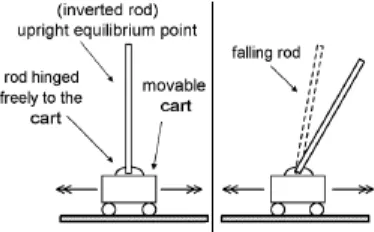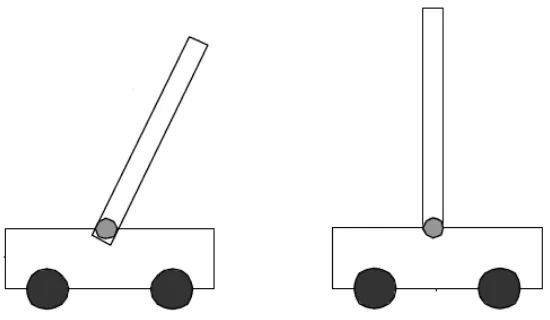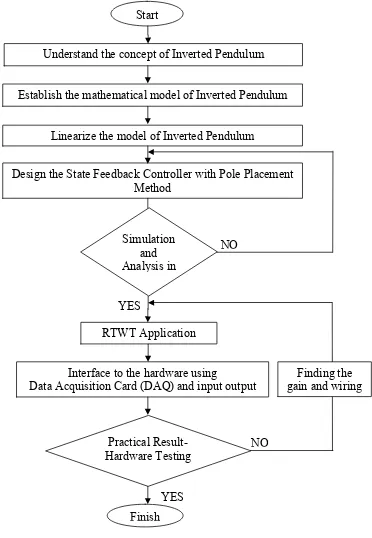CONTROL OF A REAL INVERTED PENDULUM
SYSTEMS USING
STATEFEEDBACK CONTROLLER
MUHD SAFWAN BIN ABDUL SATAR
CONTROL OF A REAL INVERTED PENDULUM SYSTEMS USING STATEFEEDBACK CONTROLLER
MUHD SAFWAN BIN ABDUL SATAR
This report is submitted in partial fulfillment of the requirements for the award of Bachelor of Electronic Engineering (Industrial Electronics) With Honours
Faculty of Electronic and Computer Engineering Universiti Teknikal Malaysia Melaka
UNIVERSTI TEKNIKAL MALAYSIA MELAKA
FAKULTI KEJURUTERAAN ELEKTRONIK DAN KEJURUTERAAN KOMPUTER
BORANG PENGESAHAN STATUS LAPORAN
PROJEK SARJANA MUDA II
Tajuk Projek : Control Of A Real Inverted Pendulum Systems Using Statefeedback Controller
mengaku membenarkan Laporan Projek Sarjana Muda ini disimpan di Perpustakaan dengan syarat9 syarat kegunaan seperti berikut:
1. Laporan adalah hakmilik Universiti Teknikal Malaysia Melaka.
2. Perpustakaan dibenarkan membuat salinan untuk tujuan pengajian sahaja.
3. Perpustakaan dibenarkan membuat salinan laporan ini sebagai bahan pertukaran antara institusi
pengajian tinggi.
4. Sila tandakan ( √ ) :
SULIT*
(Mengandungi maklumat yang berdarjah keselamatan atau kepentingan Malaysia seperti yang termaktub di dalam AKTA RAHSIA RASMI 1972)
TERHAD* (Mengandungi maklumat terhad yang telah ditentukan oleh
organisasi/badan di mana penyelidikan dijalankan)
TIDAK TERHAD
Disahkan oleh:
__________________________ ___________________________________
(TANDATANGAN PENULIS) (COP DAN TANDATANGAN PENYELIA)
Alamat Tetap: No 1, Taman Dahlia, 08000 Sungai Petani, Kedah
“I hereby declare that this report is the result of my own work except for quotes as cited in the references.”
Signature : ………
Author : ………
“I hereby declare that I have read this report and in my opinion this report is sufficient in terms of the scope and quality for the award of Bachelor of Electronic Engineering
(Industrial Electronics) With Honours.”
Signature : ………
Supervisor’s Name : ………
ACKNOWLEDGEMENT
I have learnt some great knowledge’s that I could not forget in my life. A lot of praise to Allah destined me to study here.
This work is a synergistic product of many good minds. It began since the first day I got this final project. I am grateful for the inspiration and friendly culture of peoples here. I would like to thanks to all of peoples here especially to my supervisor and my team work.
For the development and production of this final report I feel deep sense of gratitude: To my parents for their loves, prays and encouragements.
To my lecturers for their guides and advices.
To my supervisor, Mr. Mohd Shakir for his carefulness, brilliant ideas and flexibility.
ABSTRACT
ABSTRAK
II LITERATURE REVIEW
2.1 Introduction 23
2.2 Background 23
2.3 Present Applications 24
2.4 System Modelling Methodology 24 2.5 Inverted Pendulum Configurations 25
2.6 Control Methodology 27
III MATHEMATICAL WORKS
3.1 Introduction 29
3.2 Mathematical Modelling of Inverted Pendulum 29 3.3 Linearized Model in State Space Form 33
IV STATEFEEDBACK CONTROLLER
4.1 Introduction 36
4.2 State Feedback without integral 38 4.3 State feedback with integral 42
V INTERFACING THE HARDWARE WITH
REAL TIME WINDOWS TARGET APPLICATION
5.1 Overview 45
5.2 Data Acquisition Card – Advantech PCI91711 46
5.4 Real Time Windows Target Application (RTWT) 49
6.2.1 Statefeedback without integral 58 6.2.2 Statefeedback with integral 59 6.3 Real Time Graph (Interfacing Results) 63
VII DISCUSSION AND FINDINGS
7.1 Open Loop System 68
7.2 Closed Loop System 69
7.3 Real Time Graph 70
VIII CONCLUSION AND RECOMMENDATIONS
8.1 Conclusion 71
8.2 Recommendations 72
REFFERENCES 73
LIST OF TABLES
NO TITLE PAGE
3.1 Plant Parameters 33
LIST OF FIGURES
NO TITLE PAGE
1.1 Model of Inverted Pendulum 17
1.2 Equilibrium points of Inverted Pendulum 19 1.3 The cart balanced Inverted Pendulum system 20 1.4 Flow chart of research methodology 22
2.1 Inverted Pendulum Configurations 26
3.1 Inverted Pendulum on cart (Modeled by K.Ogata, 1978) 30 3.2 Inverted Pendulum plant in MATLAB’s Simulink 35 4.1 Basic structure of state feedback controller 37 4.2 Block diagram of a plant with a state feedback controller 37 4.3 State feedback block diagram in the Simulink 41 4.4 Gain of the state feedback controller in Simulink 42 4.5 State feedback controls with steady state (SS) gain 43 4.6 State feedback with integral block diagram at Simulink 44 5.1 The block diagram representing the interface process 45 5.2 Data Acquisition Card – Advantech PCI91711 46
5.3 Wiring board – ADAM93968 47
5.4 I/O connector pin assignments for the PCI91711 47 5.5 Connection between the hardware and wiring board 48 5.6 Development process to interface with RTWT 49 5.7 Step to run inverted pendulum in real time 51
5.9 I/O blocks to run the inverted pendulum controller 52
6.1 Graph of the unstable system based on the system plant 56 6.2 Graph for the position and angle 58
6.3 Graph of the position, angle and force 59 6.4 Graph for disturbance=0.01, theta = 0.95rad 61 6.5 Graph for disturbance=0.02, theta = 0.95rad 61 6.6 Maximum input disturbance that can be handle by the system, 62
disturbance = 0.03
LIST OF ABBREVIATIONS
A/D 9 Analog/Digital ANG 9 Analog
COM 9 Common
CPU 9 Central Processing Unit CW/CCW 9 Clockwise/Counter Clockwise D/A 9 Digital/Analog
DAQ 9 Data Acquisition DC 9 Direct Current
DIN 9 Deutsches Institut für Normung I/O 9 Input/Output
PC 9 Personal Computer
PCI 9 Peripheral Component Interact RTWT 9 Real Time Windows Target SCSI 9 Small Computer System Interface SFC 9 Statefeedback Controller
CHAPTER I
INTRODUCTION
1.1 Overview
Inverted pendulum system is a nonlinear unstable system, an ideal experiment platform for teaching control theories and conducting various control experiments. Many abstract control concepts, such as the stability and the controllability of a control system, can all be shown visually through the inverted pendulum system. In addition to educational purposes, an inverted pendulum is also a research area for many researchers of modern control theories. Through the continuous research on new ways of controlling inverted pendulum, researchers have developed new control methods, and apply them to the high tech areas such as aeronautical engineering and robotics.
The inverted pendulum is an intriguing subject from the control point of view due to their intrinsic nonlinearity. The problem is to balance a pole on a mobile platform that can move in only two directions, to the left or to the right. This control problem is fundamentally the same as those involved in rocket or missile propulsion.
Being an under9actuated mechanical system and inherently open loop unstable with highly non9linear dynamics, the inverted pendulum system is a perfect test9bed for the design of a wide range of classical and contemporary control techniques. Its applications range widely from robotics to space rocket guidance systems. Originally, these systems were used to illustrate ideas in linear control theory such as the control of linear unstable systems. Their inherent non9linear nature helped them to maintain their usefulness along the years and they are now used to illustrate several ideas emerging in the field of modern non9linear control.
Figure 1.2 Equilibrium points of Inverted Pendulum
The considerations in the thesis are based on the real inverted pendulum trainer situated in the university. A single inverted pendulum is mounted on a moving cart. A DC motor controls the translation motion of the cart, through a belt mechanism. The motor is driven by DC electronic system, which also contains controller circuit. The inverted pendulum as an object of control is inherently unstable and nonlinear system. In order to balance the pendulum in the inverted position the pivot must be continuously and quickly moved to correct the falling pendulum.
1.2 Objectives
a. To synthesis the mathematical model of the Inverted Pendulum based on the modeling of inverted pendulum by K.Ogata (1978).
b. To design a statefeedback pole placement control techniques to control the cart’s position and the rod’s angle of the Inverted Pendulum.
c. To carry out the simulation works for the controllers in MATLAB before applied to the real system.
1.3 Problem Statement
It is virtually impossible to balance a pendulum in the inverted position without applying some external force to the system. The cart balanced Inverted Pendulum system, shown below, allows this control force to be applied to the pendulum cart.
Figure 1.3 The cart balanced Inverted Pendulum system
This Inverted Pendulum provides the control force to the cart by means of a DC motor through a belt drive system. The outputs from the system can be carriage position, carriage velocity, pendulum angle and pendulum angular velocity. The pendulum angle is fed back to an Analog Controller which controls the DC motor, ensuring consistent and continuous traction.
The problem involves a cart, able to move backwards and forwards, and a pendulum, hinged to the cart at the bottom of its length such that the pendulum can move in the same plane as the cart, shown below. That is, the pendulum mounted on the cart is free to fall along the cart's axis of motion. The system is to be controlled so that the pendulum remains balanced and upright, and is resistant to a step disturbance.
This problem involves a simple coupled system. If the pendulum starts off9 centre, it will begin to fall. The pendulum is coupled to the cart, and the cart will start to move in the opposite direction, just as moving the cart would cause the pendulum to become off centre. To stabilize the system, such to keep the pendulum in upright position, a feedback control system must be used.
1.4 Scope of Works
The scope of work involves the whole process that will be cover in this project. The scope of work is simply can be described as below:
a) Synthesis the mathematical model of Inverted Pendulum modeled by K.Ogata (1978)
b) Design the state feedback controller based on the pole placement method controller to control the Inverted Pendulum.
c) Implement the design of the controller in MATLAB software.
d) Interfacing between the software and the hardware using the Data Acquisition Card (DAQ) based on with Real Time Windows Target Application (RTWT).
1.5 Research Methodology
Figure 1.3 shows the idea and approach in order to achieve the objective of this project.
Start
Understand the concept of Inverted Pendulum
Establish the mathematical model of Inverted Pendulum
Design the State Feedback Controller with Pole Placement Method
Linearize the model of Inverted Pendulum
Interface to the hardware using
Data Acquisition Card (DAQ) and input output Simulation
CHAPTER II
LITERATURE REVIEW
2.1 Introduction
The literature review undertaken as a part of the inverted pendulum project was focused on understanding the background and application of inverted pendulum systems, mathematical modeling, control, and other successful projects of a similar nature.
2.2 Background
2.3 Present Applications
Inverted pendulum is currently used as teaching aids and research experiments. Quanser (2004), a supplier of educational and research based equipment produce modular systems which can be configured as single or double inverted pendulum. Their range offers both a rotary and a linear version. Many researchers have also built their own inverted pendulum systems (Åström and Furuta, 1996) to suit their investigations.
2.4 System Modeling Methodology
Chinichian (1990) design and analyze a controller for balancing one pendulum with two degrees of freedom, “spatial inverted pendulum”. The pendulum, with two degrees of freedom, has a three dimensional motion, and it will be more analogous to the design of a controller for attitude control during launching a rocket. A full state9variable feedback controller design for a state9space linear model of a three dimensional inverted cart/pendulum system is presented. This design was based on pole9placement technique. Alternative solutions to the simple pole9placement technique were also proposed to exploit non9uniqueness of the feed9back gains for a certain closed9loop pole locations and the closed9loop system response was simulated on a digital computer.
The rapid increase of the aged population in countries like Japan has prompted researchers to develop robotic wheelchairs to assist the infirm to move around (Takahashi, 2000). The control system for an inverted pendulum is applied when the wheelchair maneuvers a small step or road curbs.



